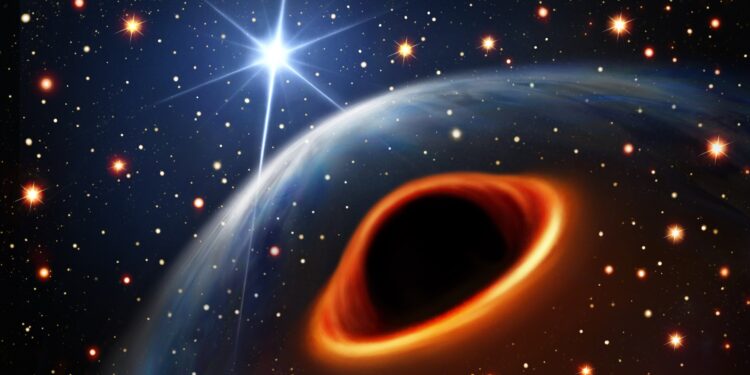Artist’s impression of the system assuming the massive companion star is a black hole. The brightest background star is its orbital companion, the radio pulsar PSR J0514-4002E. The two stars are separated by 8 million kilometers and circle every seven days. Credit: Daniëlle Futselaar (artsource.nl)
An international team of astronomers has discovered a new, unknown object in the Milky Way, heavier than the heaviest known neutron stars and yet lighter than the lightest known black holes.
Using the MeerKAT radio telescope, astronomers from a number of institutions, including the University of Manchester and the Max Planck Institute for Radio Astronomy in Germany, discovered an object orbiting a rotating millisecond pulsar fast located about 40,000 light years away in a dense group of stars. known as a globular cluster.
Using the millisecond pulsar clock ticks, they showed that the massive object was within what is known as the black hole mass gap.
This could be the first discovery of the coveted radio pulsar-black hole binary; a stellar pairing that could enable new tests of Einstein’s general relativity and open the doors to the study of black holes.
The results are published in the journal Science.
Ben Stappers, UK project leader and professor of astrophysics at the University of Manchester, said: “Either possibility regarding the nature of the companion is exciting. A pulsar-black hole system will be an important target for testing theories of gravity and a heavy neutron star. will provide new knowledge in nuclear physics at very high densities. »
When a neutron star – the ultra-dense remains of a dead star – gains too much mass, usually by consuming or colliding with another star, it collapses. What happens to them after they collapse is the source of much speculation, but it is thought that they could become black holes, objects so gravitationally attractive that even light cannot escape them.
Astronomers estimate that the total mass needed for a neutron star to collapse is 2.2 times the mass of the Sun. Theory, supported by observation, tells us that the lightest black holes created by these stars are much larger, about five times more massive than the sun, giving rise to what is known as the “black gap.” mass of black holes.
The nature of the compact objects in this mass gap is unknown and detailed study has so far proven difficult. The discovery of the object can help to finally understand these objects.
Professor Stappers added: “The ability of the highly sensitive MeerKAT telescope to reveal and study these objects enables a big step forward and gives us a glimpse of what will be possible with the Square Kilometer Array.”
The discovery of the object was made while observing a large star cluster known as NGC 1851 located in the southern constellation of Columba, using the MeerKAT telescope.
The globular cluster NGC 1851 is a dense collection of ancient stars that are much denser than stars in the rest of the galaxy. There are so many people here that stars can interact with each other, disrupting their orbits and, in the most extreme cases, colliding.
The astronomers, part of the international Transients and Pulsars with MeerKAT (TRAPUM) collaboration, believe it was one of these collisions between two neutron stars that created the massive object currently orbiting the radio pulsar.
The team was able to detect faint pulses coming from one of the stars, identifying it as a radio pulsar, a type of neutron star that spins rapidly and sends beams of radio light out into the universe like a cosmic beacon .
History of the potential formation of the radio pulsar NGC 1851E and its exotic companion star Credit: Thomas Tauris (Aalborg University / MPIfR)
The pulsar rotates more than 170 times per second, with each rotation producing a rhythmic pulse, like the ticking of a clock. The ticking of these pulses is incredibly regular and by observing how the tick times change, using a technique called pulsar synchronization, they were able to make extremely precise measurements of its orbital motion.
Ewan Barr of the Max Planck Institute for Radio Astronomy, who led the study with colleague Arunima Dutta, explained: “Think of it like you could put a near-perfect chronometer into orbit around a star nearly 40 000 light years, then be able to time these orbits with microsecond precision.
The regular timing also allowed a very precise measurement of the system’s location, showing that the object orbiting the pulsar was not a regular star but an extremely dense remnant of a collapsed star. Observations also showed that the companion had a mass both larger than that of any known neutron star and yet smaller than that of any known black hole, placing it squarely within the gap of mass of the black hole.
Although the team can’t say conclusively whether they discovered the most massive known neutron star, the lightest known black hole, or even an exotic new star variant, what is certain is that is that she discovered a unique laboratory for probing the properties of matter under the most extreme conditions. extreme conditions in the universe.
Arunima Dutta concludes: “We are not done with this system yet.
“Discovering the true nature of the companion will be a turning point in our understanding of neutron stars, black holes and anything else that might be hiding in the black hole mass gap.”
More information:
Ewan D. Barr et al, A pulsar in binary with a compact object in the mass gap between neutron stars and black holes, Science (2024). DOI: 10.1126/science.adg3005. www.science.org/doi/10.1126/science.adg3005
Provided by the University of Manchester
Quote: Lightest black hole or heaviest neutron star? MeerKAT discovers a mysterious object in the Milky Way (January 18, 2024) retrieved January 18, 2024 from
This document is subject to copyright. Apart from fair use for private study or research purposes, no part may be reproduced without written permission. The content is provided for information only.



